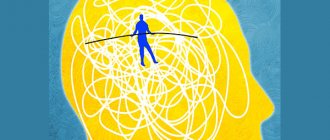Such ignorance gives rise to a huge number of misconceptions. People suffering from schizophrenia are considered dangerous to society, they are attributed with multiple personalities and a tendency to violence. But in fact, not all schizophrenics are such, and mild forms of the disorder may not be noticed by others at all.
What is schizophrenia
This is the name for a mental disorder in which there is a disturbance in thinking, self-perception, emotions and behavior. Schizophrenics do not suffer from split personality, it is a different mental disorder. This disease, first of all, makes a person stingy with emotions; he gradually withdraws into himself and stops reacting to the people around him. Main symptoms:
- Hallucinations. A person begins to see, hear and feel what is not really there.
- Rave. False beliefs and suspicions arise in the head of a schizophrenic. He claims that someone is following him, trying to harm him in some way, etc. The presence of irrefutable facts does not convince him otherwise. Sometimes a strong belief may develop that someone is stealing thoughts from your head or, conversely, putting in someone else’s.
- Behavioral disorders. A person suffering from schizophrenia may walk aimlessly from side to side, mutter something, freeze in one position for a long time, or suddenly start laughing. The appearance becomes sloppy as the schizophrenic stops taking care of himself.
- Speech organization disorders. Statements can be incoherent and are often pronounced out of place.
- Emotional disturbances. Schizophrenia is often accompanied by apathy. Facial expressions and gestures have no connection with the emotions expressed.
Manifestations indicating excessive mental activity are called psychoproductive or positive. These are thought disorders, hallucinations and delusions. The absence of normal emotional reactions, apathy, and inability to have fun are classified as the second group of symptoms - psychodeficient or negative.
To make a diagnosis, it is necessary to observe the patient for a long time. Manifestations of the disorder must be persistent and present for at least 6 months.
Characterological changes in schizophrenia
- loss of interest in work, study and previous hobbies;
- reluctance to take care of one’s appearance and indifference to personal hygiene, or obvious pretentiousness and absurdity in clothing;
- stopped helping at home and is indifferent to family events;
- coldness, indifference and hostility towards family members, especially the mother;
- a person’s entire behavior shows that he is listening to something, hiding from someone, complaining about unusual smells and unusual changes in the body, while becoming wary and distrustful;
- without explanation, spoils the furnishings of the house or throws away necessary things;
- you notice ridiculous hobbies, or an increased interest in religion, esotericism and paranormal phenomena, without any productive activity in these areas;
- alternating periods of aggression, feelings of guilt and euphoria, without confirming external reasons;
- expressing unusual, and even pretentious, complaints about one’s appearance or the functioning of internal organs;
- periods of causeless psychomotor agitation or prolonged freezing in one position.
If your loved one shows at least one sign characteristic of schizophrenia, find an opportunity to show it to a psychiatrist. Contacting a private psychiatric clinic will allow him to maintain complete anonymity of treatment and avoid registration with a psychiatrist (dispensary observation).
How to recognize schizophrenia in a child
Recognizing schizophrenia in childhood can be difficult when its onset is gradual. When the disease debuts acutely, the symptoms of the disease are pronounced, within the framework of a psychotic state.
It should be noted that not every psychosis is a sign of the onset of schizophrenia. If there is an obvious psychotraumatic situation of pronounced intensity, then most likely we are talking about a polymorphic psychotic disorder with symptoms of schizophrenia. When the onset of psychosis does not have a noticeable external cause or the acute condition lasts more than 3-4 months, the prognosis of the disease is less favorable.
If the child has fallen into a stupor, or is so excited that you cannot calm him down for a long time by any known means. Or it seems to you that he is clearly not there, calls himself a fictitious name, talks nonsense and at the same time is clearly alarmed and scared - call an ambulance.
Most often, hebephrenic and catatonic types of schizophrenia begin in childhood.
With a more gradual onset, or a predominance of damage to the emotional-volitional sphere of the child’s psyche, the signs of the disease can be brightened up and hardly noticeable to parents.
Relatives of the child should be wary if:
- the child’s character has clearly and dramatically changed;
- there are periods of uncontrolled aggression, including with loved ones;
- the child stopped showing cognitive activity, became withdrawn and indecisive;
- does not participate in any family events, including holidays, strives to be alone in the room, sits alone for a long time in the corner or under the bed;
- speech has become incoherent, has lost its meaning and consistency of presentation, the child complains of waking nightmares.
- the child automatically repeats your words, actions and movements.
- the baby grimaces all day or runs aimlessly from corner to corner, it is impossible to force him to do anything useful, and sudden mood changes are noted for no obvious reason.
Usually parents, especially mothers, intuitively feel that something is wrong with the child, he has become cold, distant and uncontrollable. It’s better to show it to a specialist than to regret the lost time later.
Reasons for development
Schizophrenia, like other mental disorders, occurs due to dysfunction of the central nervous system. A malfunction occurs in certain brain structures, which leads to disruption of neural connections. They are not destroyed at all, just the commands given to the central nervous system become “incorrect”.
To date, there is no reliable information about why exactly schizophrenia develops. Most researchers believe that this disorder is hereditary. That is, the presence of people with schizophrenia in a family several times increases the likelihood of developing the disease in other family members. But so far no one has been able to identify a single “schizophrenia gene.” Most likely, there is some gene combination that makes a person vulnerable to this disorder, but does not necessarily cause it. A combination of various factors plays a major role: a person’s environment, genetics, individual characteristics of the body, etc.
Sometimes you can come across statements that a person has gone crazy from severe stress. But psychological trauma does not lead to schizophrenia; it can only give impetus to the development of the disease, if a person has such a predisposition.
The first signs of schizophrenia can be detected at different ages, but in a larger number of patients this disorder began to develop between the ages of 16 and 25 years. This period accounts for the greatest psycho-emotional load associated with adolescence in adolescence, first love, puberty and hormonal changes. All this also provokes the development of mental illnesses, to which a person has a predisposition.
Scientists also have not found a relationship between the likelihood of developing schizophrenia and belonging to a particular race, nationality, gender, etc.
The prevalence of this disorder is approximately the same throughout the world, affecting approximately 1% of the world's population.
Onset of schizophrenia symptoms
The manifestation of schizophrenia is often provoked by heavy loads, alcoholism or other stressful situations. Although the disease itself is not a response to a traumatic situation, as with neurosis, excessive stress causes a breakdown in the psyche of a person who has a genetic predisposition to this.
In some forms of schizophrenia, for example paranoid, the disease begins acutely and is accompanied by delusions and hallucinations. In others, as in simple schizophrenia, the destruction of the patient’s personality gradually increases, with the loss of the ability to act purposefully and constructively.
Symptoms of mild and malignant forms of schizophrenia
Schizophrenia can occur either in a mild form or have a malignant rapid course.
Paranoid and simple forms of schizophrenia can have a milder and more gradual course, when between attacks of schizophrenia a person continues to live his usual life. Personality changes occur gradually. The so-called sluggish schizophrenia - schizotypal disorder - passes without the formation of a personality defect in the patient.
Hebephrenic and catatonic schizophrenia often have a malignant continuous course. The disease usually begins in childhood and adolescence, interfering with a person's development and acquisition of necessary skills. Patients with a malignant course of the disease often become habitual residents of psychiatric clinics. A phenomenon called hospitalism is emerging – the fear of being left alone with one’s condition, without help from medical personnel.
Febrile schizophrenia is a type of severe and rapid course of schizophrenia with catatonia. In addition to the catatonic syndrome and confusion, this form of catatonic schizophrenia is accompanied by fever against a background of elevated temperature, disruption of the autonomic nervous system and severe exhaustion of the body. The patient's consciousness is disturbed, he experiences hallucinations and delirium, his speech is incoherent, and excitement may be accompanied by convulsions. Since this form of the disease is very severe, associated with cerebral edema and possible disturbances in the functioning of internal organs, such patients are treated by psychiatrists-resuscitators in a special intensive care unit of a psychiatric hospital. Timely specialized care for patients with febrile schizophrenia contributes to a favorable exit from this condition.
Alcohol schizophrenia
Often, ordinary people confuse alcoholic psychosis with the manifesto (first psychosis) of schizophrenia. Indeed, alcohol and drug intoxication can provoke the onset of schizophrenia. But alcoholic psychoses have their own characteristics.
There are several types of alcoholic psychosis:
- alcoholic delirium (delirium tremens) - develops against the background of alcohol withdrawal, patients see devils and insects and do not understand where they are;
- alcoholic hallucinosis – expressed in the form of auditory hallucinations of a critical and threatening nature, the patient is sure that those around him can also hear these voices; usually develops during heavy drinking;
- delusional psychosis - develops with chronic alcoholism and most often manifests itself as delusions of jealousy with ideas of poisoning and persecution;
- psychosis in alcoholic encephalopathy - due to organic brain damage due to prolonged alcoholism, the patient develops psychopathic behavior and becomes uncontrollable; Individual delusional statements in combination with simple visual and auditory hallucinations are possible.
Only a psychiatrist can understand the type of psychosis and make a diagnosis through direct observation of the patient. Alcoholic psychosis indicates severe damage to the internal organs and nervous system of a person, and requires immediate hospitalization of the patient in a psychiatric hospital.
Some types of schizophrenia are similar in their symptoms to the manifestations of neurosis or psychopathy. Conventionally, neurosis-like and psychopath-like forms of the disease are distinguished.
Neurosis-like schizophrenia symptoms
Pseudoneurotic schizophrenia can occur with a clinical picture similar to the manifestation of neurosis: anxiety, sleep disturbance, irritability, weakness, and others. Hence its name. But along with this, some symptoms characteristic of schizophrenia are also observed: isolation, withdrawal into one’s inner world, coldness in communicating with loved ones with irritability and hostility towards them, dual (ambivalent) feelings and relationships. Characterized by obsessive states, depersonalization phenomena and fears. In this case, hallucinatory-delusional symptoms do not appear and a personality defect does not occur, disability is excluded.
Treatment of neurosis-like schizophrenia is carried out by a psychotherapist. It includes individual and group work with the inner world of a person.
Psychopathic-like schizophrenia symptoms
Pseudopsychopathic schizophrenia is similar to the manifestation of a personality disorder: antisocial lifestyle, aggressiveness, cynicism, callousness towards people and animals, theft, alcoholism and drug addiction. This symptomatology is combined with mild symptoms of schizophrenia, the same as with neurosis-like schizophrenia.
Treatment takes place under the supervision of a psychiatrist-psychotherapist. It usually includes both drug therapy and various types of psychological assistance and social adaptation.
Diagnostics
Schizophrenia has a wide variety of forms, so very often experts use the name of this disorder in the plural. The main symptoms, such as delusions and hallucinations, can also occur in other pathological conditions. Therefore, during diagnosis, it is very important to differentiate schizophrenia from other disorders.
To make a diagnosis, a psychiatrist uses the following methods:
1. Clinical and anamnestic examination . This examination is carried out at the first appointment. The doctor listens to the patient's complaints and examines him. Of great importance is not only the person’s condition at the moment, but also what happened to him before the onset of the disease.
Despite the fact that schizophrenia develops due to a disruption in the relationship between nerve cells, external factors (maternal pregnancy, trauma, conflicts, stress, infectious diseases, etc.) can negatively affect the course of the disease and interfere with recovery;
2. Pathopsychological examination . This diagnostic technique includes a series of tests relating to the emotional and volitional sphere of a person. The most famous is the ink blot test (Rorschach test), during which the patient is presented with 10 cards with color and black and white blots.
The Luscher test is also effective in diagnosing schizophrenia. It is based on the doctrine that a person’s perception of color depends on his psycho-emotional state.
These and other techniques allow you to assess the “unusuality” of a schizophrenic’s thinking. The fact is that the brain of a healthy and a sick person works differently. A person suffering from schizophrenia can see a whole story in a simple spot, whereas for an ordinary person it will remain a spot.
During psychological research, collections of questions are used. For example, a doctor might ask what a felt-tip pen and a boot have in common. A healthy person would be perplexed by such a question, but a schizophrenic would give the answer immediately. Such creativity in judgment is due to illness, not genius, although many brilliant people are often called crazy;
3. Neurotest and Neurophysiological test system (NTS) . In a laboratory setting, a capillary blood test (neurotest) can be performed, which helps confirm the diagnosis in doubtful cases. Thanks to it, certain markers of inflammation are detected in the blood, their number is directly proportional to the severity of the patient’s disease.
The neurophysiological test system is a modern diagnostic technique in psychiatry. During its implementation, a person’s reaction to external stimuli (light and sound) is assessed. With the help of NTS, you can accurately determine whether a person has schizophrenia or not. The use of EEG and MRI devices in these cases will be useless.
Only after a comprehensive diagnosis, a thorough examination and in full compliance with international criteria can a person be diagnosed with schizophrenia. In many cases, this requires a consultation with the participation of doctors of science and doctors of the highest category.
Schizophrenia
19171 May 13
IMPORTANT!
The information in this section cannot be used for self-diagnosis and self-treatment.
In case of pain or other exacerbation of the disease, diagnostic tests should be prescribed only by the attending physician. To make a diagnosis and properly prescribe treatment, you should contact your doctor. Schizophrenia: causes, symptoms, diagnosis and treatment methods.
Definition
Schizophrenia is one of the most common mental disorders, characterized by a combination of productive (hallucinatory, delusional, catatonic, affective, etc.) and negative (apathy, abulia, alogia, emotional and social withdrawal, etc.) symptoms, behavioral and cognitive disorders (memory disorders , attention, thinking, etc.).
More than 20 million people suffer from schizophrenia worldwide.
Causes of schizophrenia The
leading causes of schizophrenia include heredity, unfavorable environment and social living conditions.
The risk of developing schizophrenia in children, one of whose parents suffers from this disease, is 7–13%, and if both parents are sick, then 27–46%. In each subsequent generation, the risk decreases. Men and women develop schizophrenia equally often, but in men the disease usually appears earlier - at the age of 18-25 years, while in women - at 25-30 years.
Environmental factors are important in the development of schizophrenia - scientists have found that urban residents are diagnosed with the disease more often than rural residents. There is a risk of this mental disorder among migrants. Obstetric and gynecological complications (premature birth, fetal hypoxia), infectious diseases and malnutrition of the mother in the first and early second trimester of pregnancy, infectious diseases during pregnancy (influenza, rubella, toxoplasmosis, herpes), as well as early childhood psychological trauma can also cause schizophrenia.
Many scientists are of the opinion that schizophrenia develops as a result of a disorder in the metabolism of neurotransmitters, in particular dopamine, in the brain. Neurotransmitters are biologically active substances that are produced by nerve cells (neurons) and transmit information from neuron to neuron and to other cells.
Classification of the disease
The International Classification of Diseases (ICD-10) identifies several forms of schizophrenia:
- paranoid (F20.0),
- hebephrenic, or hebephrenic (F20.1),
- catatonic (F20.2),
- undifferentiated (F20.3),
- post-schizophrenic depression (F20.4)
- residual schizophrenia (F20.5)
- simple (F20.6).
In addition, schizophrenia is divided according to the type of course: first episode, episodic course, episodic course with an increasing defect, low-progressive course, etc.
In the clinical picture of schizophrenia, separate symptom complexes are distinguished:
- positive symptoms
- negative symptoms
- disorganization of speech and thinking,
- affective symptoms,
- cognitive impairment,
- catatonic symptoms, etc.
Symptoms of schizophrenia
The most active period of the disease is the first 5 years after the first psychotic episode.
Before the development of an acute psychotic episode, the patient may experience so-called prodromal phenomena (harbingers) for weeks, months or even years. The patient loses interest in work, social activities, his appearance, and hygienic habits; cognitive impairment occurs (impaired thinking, attention, memory, speech), and changes in motor skills. Perceptual disturbances, unexplained anxiety, and mild depression may occur.
In 75% of patients, the prodromal period lasts more than 5 years.
The paranoid form of schizophrenia
is characterized by severe hallucinations and/or delusions. The patient may hear various sounds, hallucinatory voices of a threatening or imperative nature (when a voice orders a person to do something), feel non-existent smells, tastes, sexual or other bodily sensations. In the paranoid form of schizophrenia, delusions may arise - a system of false beliefs built on erroneous, illogical conclusions. A person may suffer from delusions of persecution (to be sure that he is being listened to or being plotted), he may have delusions of influence (the patient thinks that he is being influenced by some devices, energies, hypnosis) or delusions of relation (when everything that happens around him is a sign or a hint), or delusions of grandeur (the patient is sure that he has extraordinary abilities, considers himself a famous person). In addition, there are delusions of meaning, high origin, special purpose, bodily changes, guilt, jealousy, etc.
Hebephrenic form of schizophrenia
usually appears in adolescence or young adulthood. This form of the disease is accompanied by pronounced and prolonged emotional flatness - the patient’s strength of experienced emotions decreases (patients note that they cannot be happy or upset, they become indifferent), they lose the ability to understand the emotions of other people, their facial expressions lose expressiveness. There is also emotional inadequacy - a person can rejoice at sad events and be upset about joyful ones. The behavior of a patient with the hebephrenic form of schizophrenia is characterized by foolishness, there are thought disorders in the form of broken speech (schizophasia) - when there is no semantic connection between words and sentences, sentences are not grammatically consistent, words and terms are used inappropriately.
In the hebephrenic form, hallucinations and delusions may be present, but they do not predominate in the clinical picture.
In
the catatonic form of schizophrenia,
the patient experiences alternating stupor and agitation. A person can freeze in one position, even a completely uncomfortable one, without reacting to external stimuli and without speaking. The patient retains consciousness, then he can talk about what happened, but at the moment of stupor he does not move, does not speak, does not perceive other people’s speech, does not eat or drink. With catatonic excitement, a person commits stereotypical aggressive actions, aimlessly destroying everything around him, so in order to avoid injury, he has to be tied up.
Both during the period of stupor and during the period of excitement, the patient may experience oneiric syndrome - fantastic visions with himself in the leading role.
In addition, with the catatonic form of the disease, negativism (a person perceives negatively everything that is offered), mutism (silence), obedience (automatic execution of instructions), stereotypy (automatically performs the same action over a significant period of time), echolalia (repetition heard words, phrases), Pavlov's symptom (reaction only to requests spoken in a whisper), etc.
For undifferentiated schizophrenia
symptoms are either insufficient to identify another form of schizophrenia or, conversely, so many that criteria for more than one form of the disease are identified.
With a simple form
There is a slow (over a year or more) development of three signs:
- a distinct change in personality, which is manifested by loss of drives and interests, inactivity and aimless behavior, self-absorption and social withdrawal;
- deepening of symptoms such as apathy, impoverished speech, hypoactivity, emotional flatness, passivity and lack of initiative, poverty of non-verbal communication (so-called negative symptoms),
- a distinct decrease in social, educational or professional productivity.
In the residual or residual form of schizophrenia,
there is a transition from the active course of the process (psychotic episodes with a predominance of productive symptoms) to the chronic stage with persistent negative symptoms - psychomotor retardation, reduced activity, emotional flatness, passivity and lack of initiative; poor speech and non-verbal communications; lack of self-care skills and social productivity.
Diagnosis of schizophrenia
In making a diagnosis, communication with the patient and, if possible, his relatives plays an important role. In addition to complaints, family history, age at which symptoms appeared, the patient’s marital status, his social status, etc. are analyzed.
To make a diagnosis and establish the form of the disease, psychiatrists use special criteria by which they evaluate the presence of positive and negative symptoms, catatonic disorders, and changes in the patient’s behavior.
In some cases, people with suspected schizophrenia, to exclude an organic cause of psychotic disorders, are recommended to consult a neurologist and conduct laboratory tests to exclude other pathologies:
- general blood analysis;
How is schizophrenia treated?
After making a diagnosis, doctors usually move on to treatment, the main goal of which is to completely eliminate the disease and its consequences. In the case of schizophrenia, doctors’ actions will be aimed at eliminating the symptoms, because they are not able to eliminate the “problems” in the patient’s brain.
Today, the medical prognosis is disappointing – schizophrenia is incurable. Doctors have some understanding of the development process of the disorder, but they do not know how to prevent it.
However, people suffering from schizophrenia are provided with qualified specialized medical care. Usually it is carried out in several directions:
- drug therapy. Traditionally, the treatment of schizophrenia uses antipsychotics that can eliminate hallucinations. During the period of exacerbation, drugs are administered by injection, and later the patient takes tablet forms. The same medications help prevent future exacerbations. Your doctor may also prescribe sedatives, tranquilizers, or antidepressants. This is necessary to eliminate anxiety, sleep disorders and other symptoms of schizophrenia.
- psychotherapy. The work of psychotherapists is aimed at working through the patient’s psychological and behavioral problems. During the conversations, the schizophrenic will learn to manage his symptoms, which will allow him to successfully adapt to society and return to normal life.
If you ask an experienced psychiatrist the question: “Is schizophrenia treatable?”, you will get a clear answer - no. But with timely and constant therapy, the patient’s condition can be improved so much that he can lead a normal life.
How to recover and is it possible to do it?
To help the patient cope with the pathological condition, an integrated approach and the help of a psychiatrist are necessary. The treating physician, family and friends, and social workers must work together. The main goal in the treatment of schizophrenia is to lead the patient to stable remission, as well as to prevent the development of hallucinations and other symptoms. When asking the question whether it is possible or not to cure the deviation, many relatives of such patients already know that the answer will be negative. However, following the recommendations of a psychiatrist, as well as taking new generation medications, will allow the patient to return to normal life for a longer period.
The most important thing when treating schizophrenia is not to miss the period of exacerbation. When the first signs of a return of the disease appear, the patient is recommended to be placed in a specialized institution under the supervision of a psychiatrist. In a hospital setting, it is much easier to prevent the suicidal tendencies of a schizophrenic and stabilize his psychological state. Full treatment of schizophrenia in a hospital under the supervision of a psychiatrist is the key to long-term remission; in addition, sometimes schizophrenics need temporary isolation from society.
Rehabilitation and social assistance
Treatment in a hospital setting can eliminate acute manifestations of the disease. With stable remission, the patient can continue to stay at home and receive the necessary care on an outpatient basis. For adaptation to be successful, you must:
- teach the patient how to properly respond to stressful situations and methods of preventing relapses;
- restore an adequate perception of the surrounding reality;
- tell the patient, his family members and close people about the disease, the features of its occurrence and course;
- normalize the functioning of memory and thinking, make it adequate;
- prepare the patient for the need to study and work.
Remission in schizophrenia can be indefinitely long, provided that the patient continues the course of maintenance drug therapy and psychotherapy. The support of loved ones, their care, love and attention is of great importance.
Myths about schizophrenia
Many myths have been created around schizophrenia, since this mental disorder scares people no less than AIDS or cancer. The most common misconceptions are the following:
1. All people suffering from schizophrenia are violent and dangerous, they belong in a special hospital. This myth is due to the fear of the unpredictability of mentally ill people in general and schizophrenics in particular. Cases of violence by the mentally ill receive too much publicity in the press, resulting in the impression that all “psychics” are dangerous.
In fact, people with schizophrenia are more likely to harm themselves than others. According to statistics, a much larger number of crimes are committed by persons under the influence of alcohol, but people who abuse alcohol are not isolated from society. Schizophrenics can lead completely normal lives if they follow the recommendations of their doctor.
2. The diagnosis of schizophrenia implies dementia and complete disability. It can be very difficult for people with various mental disorders to organize their own lives, but with the support of loved ones they can cope with the destructive influence of the disease. As for intellectual abilities, they are no higher or lower than those of healthy people.
Schizophrenia affects the way of thinking, not intellectual development. For example, John Forbes Nash Jr., who suffered from schizophrenia, learned to ignore his disorder. He became famous for receiving the Nobel Prize in Economics (1994). The film “A Beautiful Mind” was made about the life of this American mathematician.
3. Parents are to blame for the development of the disease. Modern research confirms that schizophrenia may be caused by heredity. However, genetic factors are not fundamental and the only ones that can influence the course of the disorder.
Its relationship with incorrect communication models in the family, pedagogical neglect and improper upbringing has not been established. Although an unfavorable environment can have a negative impact on the healing process, it cannot be considered the main cause of the development of schizophrenia.
4. Creative and brilliant people suffer from schizophrenia. Indeed, history contains many examples of great artists, poets and musicians suffering from various mental disorders. The artist Vincent Van Gogh and the writer N.V. Gogol were schizophrenics; it is attributed to Isaac Newton, Albert Einstein and other famous people. But the talents of these people have nothing to do with mental illness.
People with schizophrenia can demonstrate the same talents, strengths and weaknesses as a healthy person.
Another myth about schizophrenia is the persistent belief that this disorder does not need to be treated. It has already been mentioned several times above that schizophrenia cannot be treated. The point is that pathological changes in the human brain are irreversible. But modern medicine is able to help a sick person cope with the negative manifestations of schizophrenia, which can greatly complicate life for both himself and his loved ones.
Features of the development of schizophrenia
A psychiatrist treats schizophrenia and helps a person cope with the manifestations of this disease. Schizophrenia can develop in childhood, in old age or in adolescence - the latter option is the most common. The disease may appear unexpectedly, but most often it develops gradually. In this case, a person begins to experience the following symptoms of schizophrenia:
- fast fatiguability;
- weakness of the body;
- feeling of internal tension;
- the person cannot cope with normal daily activities;
- the person becomes withdrawn and withdraws into himself;
- behavior becomes strange;
- social ties are severed;
- others see changes in a person.
Schizophrenia progresses differently for each person, but at the head of all forms of this disease is the gradual formation of a decrease in willpower. This may manifest itself in the fact that a person may drop out of college in the last year of study, he may quit his favorite job, or he may not come to the registry office on the appointed day for his own wedding. As the disease progresses, the symptoms become more severe.
The person begins to behave strangely. Behavior becomes daring and incomprehensible to ordinary people. He begins to perceive the world and society around him differently. Most often, a psychotherapist diagnoses this disease at a time when the patient is at a serious stage of development of the disease. This is a disease in which early or late diagnosis is not of particular importance, because schizophrenia manifests itself in a person in influxes at certain periods of time. During remission, schizophrenics feel like normal people, but when the acute psychological phase of the disease sets in, they become very strange, cannot reason logically, and are lost in events and people around them. In psychotherapy, this is called a self-identity problem.
Assistive treatments for schizophrenia
Today you can find a lot of advertisements about non-traditional methods of treating various mental disorders, including schizophrenia. Patients are offered remedies prepared from medicinal herbs by monks or developed in secret laboratories by super-scientists.
You can also buy a device on the Internet that will restore the affected areas of the brain. But all this is just another attempt by enterprising businessmen to make money on someone else’s misfortune. It is not possible to cure schizophrenia using these methods, although herbal medicines will have a general strengthening effect on the body.
If we talk about auxiliary methods of treating schizophrenia, the most effective may be:
- art therapy. Practicing various types of art has a beneficial effect on the psyche. When working with schizophrenics, music and drawing classes are most often used;
- family therapy. During group sessions, assistance is provided not only to the patient himself, but also to his family members. A healthy person often also needs psychotherapeutic help, because living next to a sick person is not at all easy;
- Alternative medicine. It is unlikely that you will be able to get rid of schizophrenia with the help of acupuncture, yoga, or breathing exercises. But with the right approach, you can forget about its manifestations;
- group therapy. Schizophrenia makes a person withdrawn and distrustful, which is why many psychotherapists practice so-called communication therapy. A special group is being created, which includes both schizophrenics and healthy people. First, patients communicate with others like themselves, and then try to build relationships with the rest of the meeting participants. Everyone benefits from such communication: schizophrenics acquire communication skills, and healthy people learn tolerance and tolerance when communicating with a mentally ill person.
If you use the above methods of treating schizophrenia together with psychotherapy and taking medications prescribed by your doctor, you can almost completely eliminate the symptoms of the disease.
Psychological therapy and social support for schizophrenia
After the patient’s condition with schizophrenia, including psychological, has been stabilized, it is recommended to move on to social work. At this stage, the attitude of relatives towards the patient plays a huge role. With their help, it is possible to “smooth out” the rehabilitation period and prevent the development of a relapse in schizophrenia. In addition, psychologists or psychotherapists are involved in working with a schizophrenic. For faster adaptation, patients may be recommended occupational therapy, drawing classes, or all kinds of training. Cognitive training plays a very important role in the rehabilitation process for schizophrenia. They teach the patient to correctly perceive and process information. At the same time, the events surrounding him become more understandable. Also during the classes, the patient trains his memory and attention. When working with a psychiatrist, a lot of time is spent on the patient’s feelings. The doctor asks you to tell him about your thoughts and inner voices, which allows you to identify false judgments. For example, many schizophrenics believe that people around them can hear their thoughts. Next, the focus is on family activities. The role of loved ones in the patient’s adaptation to normal life is very important. At the same time, the work is carried out not only with the patient, but also with his family. It is very important to convey information about schizophrenia to relatives and teach them to act appropriately when a particular situation arises. Only complete psychological adaptation can help patients with schizophrenia fully realize themselves in society, for example, graduate from college or find a job.








